With the event of ether (ETH) launching above the USD 4000 threshold in May 2021, one couldn’t help but wonder whether decentralized applications could be nearing mainstream adoption. With NFTs becoming a household name and thousands of applications being run on the Ethereum network, it’s no wonder the token has become so hot recently.
With all of this happening, Ethereum Serenity, or Ethereum 2.0, is one of the most hyped upgrades in the industry. And with that, the question that brews in the minds of bullish Ethereum fans is: How do I stake my ETH for the upgraded version of the most used protocols around?
Let’s explore.
What is Ethereum 2.0?
Serenity, or Ethereum 2.0, if successful, will have the usability, scalability, and sustainability to operate for users all over the world. In its current state, Ethereum has high transaction fees, sometimes even costing USD 200 to go through. And even if it’s usable, one would find it difficult to scale and create a whole new world of next-generation decentralized applications if the transactions per second remain at 10-15 when traditional financial tools like Visa operate on 17,000. Also, mining uses immense electrical energy. Although media often exaggerates this, it is still great that this issue will be handled by Proof-of-Stake, which is an alternative to the mining mechanism Proof-of-Work.
Once Proof-of-Stake comes out, Ethereum will operate on an alternate consensus mechanism. It currently runs on Proof-of-Work, which uses mining in order to validate blocks. Proof-of-Stake runs on validator nodes and should be more usable, scalable, and sustainable.
This will make DeFi applications like Aave and Compound easier to run. If decentralized financial tools need USD 100 to make a single transaction, not many will believe in decentralized protocols as an alternative to mainstream finance. Also, if it takes that amount to sell a piece of digital property or artwork, one would wonder about the widespread use of it all.
Ethereum 2.0 aims to put to an end all of those concerns and allow its extensive worldwide user base to grow and make use of the protocol smoothly.

Why Stake Ethereum for Ethereum 2.0?
The main reason why many would probably want to stake Ether is to acquire the APR or Annual Percentage Revenue, which can range from 6% – 15%. The minimum requirement is 32 ETH, so you can net anywhere from 2 – 5 ETH with these rates. (disclaimer: this isn’t financial advice).
What’s the catch? You have to lock up your ETH for years. To some who don’t have 32 ETH to just lock up on the fly or like to use ETH for other decentralized applications, they would be hesitant to choose this option. You have to do this until the Ethereum 2.0 protocol rolls around, which may not take place until years from now. For those who have limited ETH or use them regularly, staking Ethereum for Ethereum 2.0 won’t be a viable option.
Alternatively, you can put them on an exchange to stake and earn rewards, but you aren’t necessarily running a validator node and staking for Ethereum 2.0.
The other reason why someone would want to stake ether is to help out the network. In order for the network to secure legitimacy, it needs to be validated by nodes, which are the individual computers that have staked ETH that are running. If you want to validate the network, help it out and get a decent reward while doing so, that could be your reason for staking.
Possible Risks of Staking ETH
Always make sure to have all of your bases covered and consult a financial advisor if you’re planning to be serious with staking Ethereum. The rewards are promising, but there are risks involved.
1. What will be Ethereum 2.0’s value?
While this may not be a problem in the long run if Ethereum 2.0’s value is incredibly high, you should still take note that the value of Eth 2.0 is unknown as of this point and will likely be different than Ether. If you’re confident that Ethereum 2.0 will be a successful project, then you should be confident that running a validator node will be beneficial.
2. Liquidation
Another possible risk is a lack of liquidation. You will not be able to withdraw your earned ETH and your staked ETH until Ethereum 2.0 is launched, which might not happen for 2 years or possibly longer. If you are not a long-term holder and are planning to sell Ethereum in this bull run or the next, then this might not sit well with you.
If you believe that cryptocurrencies will be the future and are planning to hold onto it long term, running a validator node might be your choice. If you plan to hold ethereum for 5+ years, you have good incentives to do so with the rewards involved.
Although there are ways to stake Ether on exchanges, which would make them more liquid, doing so does not directly support the network or decentralization in general.
3. Bugs
And although Ethereum is one of the most reliable blockchain networks around and powers thousands and thousands of applications that are being used daily, you should still be aware that if there are any bugs. You may lose some or, in the unlikely worst scenario, all of your Ethereum in the case of an extreme bug. Although there have been very few instances of this happening, be aware that they are a possibility.
That being said, there are tons of investors already running validator nodes, so it isn’t as if you’re left on an island. You’ll be part of a whole Ethereum community that has already supported and staked on the blockchain for years.
Hardware Requirements for Staking Ethereum 2.0
Although not as intensive as mining, you still need a decent rig in order to set up a validator node. This is to ensure that the applications you are using to stake are running at optimal capacity. If you are planning to stake, then having the best possible setup will give you the necessary tools.
Prysm has these requirements for staking Ethereum:
Minimum specifications
Operating System: 64-bit Linux, Mac OS X 10.14+, Windows 64-bit
Processor: Intel Core i5–760 or AMD FX-8100 or better
Memory: 4GB RAM
Storage: 20GB available space SSD
Recommended specifications
Processor: Intel Core i7–4770 or AMD FX-8310 or better
Memory: 8GB RAM
Storage: 100GB available space SSD
All of these specifications can be found on modern PCs, so they shouldn’t be too unrealistic for many crypto holders who are already planning to stake, given the barrier to entry already in place.
Keep in mind, just because these are the recommended specifications doesn’t mean that you won’t benefit from a stronger system. The stronger your system, the more failsafe it will be.
Costs of Staking ETH
The current price of ETH at the time of writing hovers around USD 2,500, meaning that USD 80,000 is already necessary to even have the possibility of the option.
This doesn’t factor in other costs like hardware and electricity to keep the node up and running. With all of these factored in, you will be spending a pretty penny to set one up.
If you are only planning to stake for ETH, then you can do this on several exchanges without factoring in hardware costs. Alternatively, there are multiple staking pools that you can choose from that may not require you to stake the full amount of ETH.
Best places to Stake for Ethereum 2.0
Although you can stake ETH on exchanges like Coinbase, it is probably better to use decentralized protocols to staking Ethereum. Not only does this keep up with the spirit of decentralization, but you are solely responsible for that validator node, rather than any of your stake being dictated by exchange or centralized application.
Setting up your own node through Prysm or the ones Ethereum suggests seems to be the way to go.
If you don’t have enough ETH, you can always stake in a pool. Although you are not running your own validator node, you are at least using your Ethereum to stake for rewards and allowing others to pool it and run validator nodes. In the coming months, more and more DeFi projects will come about that allow you to stake ether for Ethereum 2.0 in pools. A notable one is RocketPool, a decentralized way to stake, which is based on much of Vitalik Buterin’s own ideas about staking Ethereum 2.0. However, RocketPool and many of these other applications coming out are not available at the moment. RocketPool will also provide a way for you to stake your ETH 2.0.

So if you want to wait for these staking options to open up, then that might be better if you want to hold for a long time. This does mean that you will have to wait on the possible rewards since getting started early will earn you more rewards.
If you can’t wait to start earning on your extra ETH, then perhaps choosing the centralized versions out now would be better for you since you’ll immediately be starting to earn rewards. If you have the resources, both options are available.
Binance BETH?
Although the steps to stake on here are incredibly simple, this way you will stake BETH. BETH is a Binance token version of Ethereum which has near a 1:1 value to ETH. Although it is easy to do this on exchanges like Binance since they cover several of the costs you would have to make like hardware and electricity, keep in mind that this isn’t decentralized. You would also be earning BETH, which you can convert into ETH on the exchange.
If you don’t care so much about the values of decentralization and want something convenient, then you could use this method. Exchanges like Binance, Coinbase and Kraken all have a way of staking ETH.
Ethereum 2.0 Validator Node Staking Process
The official one requires you to have your own 32 ETH. It is recommended to use a hardware wallet to stake ETH as those are less susceptible to attacks than entirely hot wallets like Metamask.
1. For starters, go to the launchpad address. Click Become A Validator.

2. Read through the instructions and accept them. It’s important to read through all of them in order to have a clear picture of the staking process.
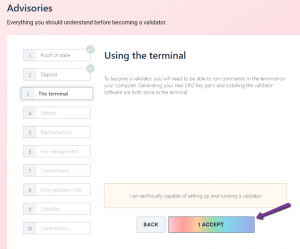
3. Ethereum recommends for you to have your own client ready to go to keep up the spirit of decentralization. All of them have their own instructions on set-up. Parity Ethereum is Ethereum’s own.
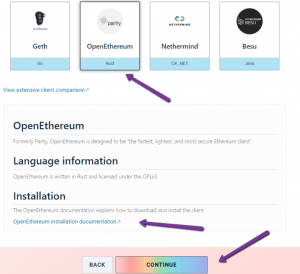
4. Next, you will choose the client for your node. The suggested one is Rust’s own Lighthouse which has its instructions, although you might like to try other clients, too.
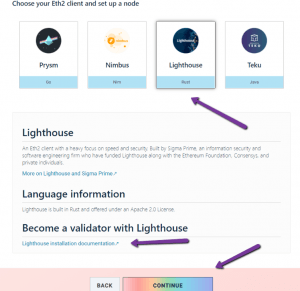
5.Next, you’ll choose your command-line app. Make sure to download it from Github.
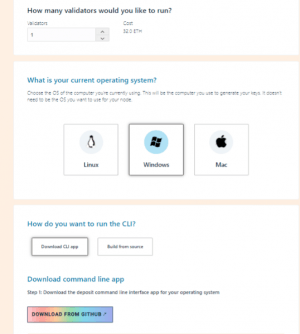
6. After that, you’ll need to jot down the seed phrase from the command prompt. And then you’ll upload your data.
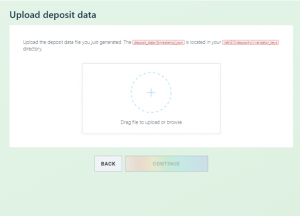
After this, you can connect your wallet and become a validator. If you want to follow a step-by-step process on how to stake ETH for Ethereum 2.0, we also recommend watching this ETH 2.0 staking guide by popular crypto YouTuber Boxmining.
Congrats, you are officially staking and helping out the Ethereum network.


